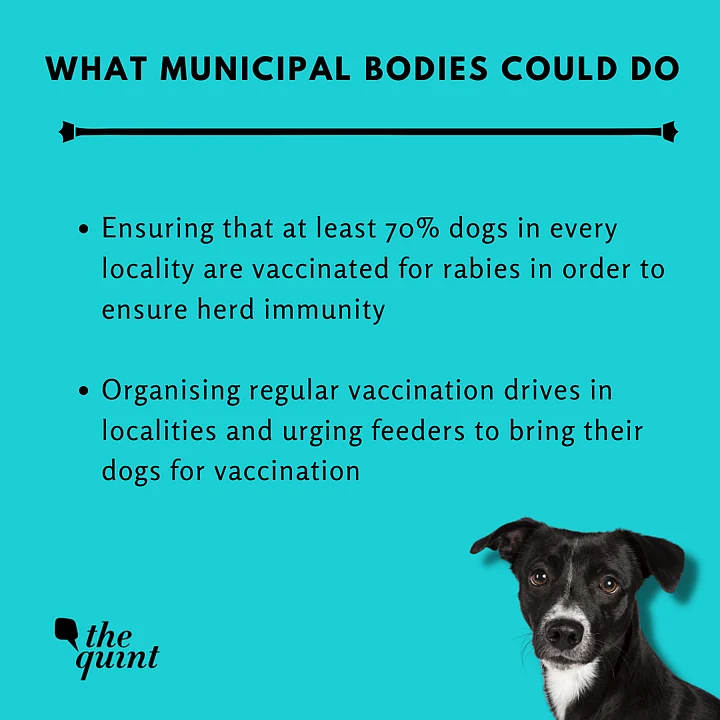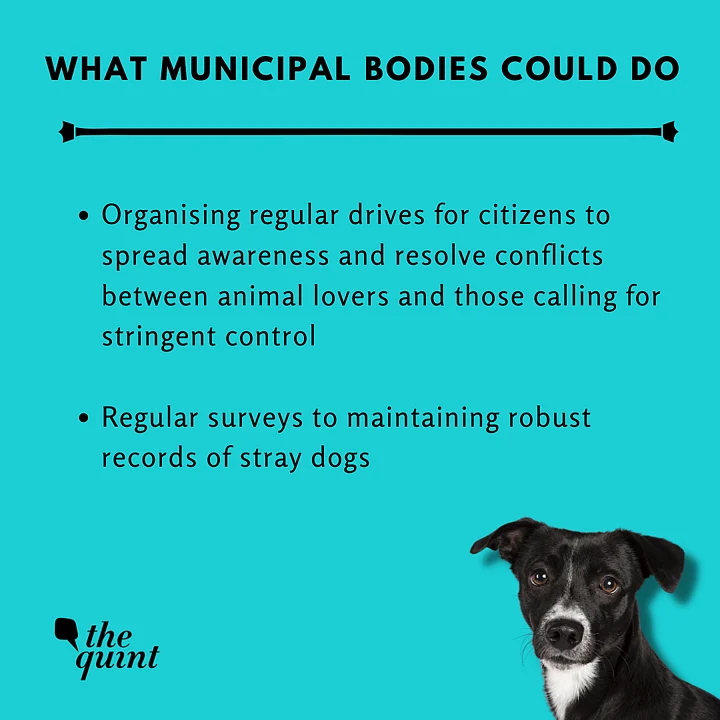Why are dogs, regarded as man's best friend, increasingly being seen as their enemies?
From Whatsapp groups of housing societies calling for measures to control pets following several 'attacks' to TV news channels flashing visuals of horrific attacks by strays, the 'menace vs management' debate is at the centrestage once again.
Several recent incidents — death of two siblings in Delhi's Vasant Kunj following attack by stray dogs, mauling of a 4-year-old child in Hyderabad, a stray dog killing a sleeping infant in a Rajasthan hospital — have reignited the debates around control of strays.
But beyond these debates, it's necessary to understand the caveats and the complexities of India's dog problem.
India Has a Stray Dogs Problem, But What's the Bone of Contention?
1. How Big is the Stray Dogs Problem in India?
Officially, India has over 60 million stray dogs. Here's some data to gauge the extent of the problem:
According to the World Health Organisation (WHO), India accounts for 36% of the global deaths due to rabies and 65% of the deaths due to rabies in the South-East Asia region.
The National Rabies Control Program reported 6,644 clinically suspected cases and deaths of human rabies between 2012 and 2022.
As of November 2022, the number of infected dogs in Kerala has doubled in the past five years with 168/300 samples (56%) found to be positive for rabies, compared to 32% in a similar study conducted in 2016.
6/12 rabies deaths in Kerala took place despite the victims having taken an anti-rabies vaccine.
Between January-October 2022, Kerala and Punjab reported over 10,000 cases of dog bites each, while Maharashtra, Gujarat, and Kashmir reported between 1,000-10,000 cases, according to a report by The Lancet.
According to a report, Delhi's Safdarjung Hospital and Ram Manohar Lohia (RML) hospital, have seen 29,698 and 18,183 dog bite cases respectively in the last six months.
Expand2. Are Attacks by Stray Dogs On the Rise?
To answer this question, renowned dog trainer and founder of Delhi’s K9 School, Adnaan Khan, attempts to explain the behavioral patterns of stray dogs and the reasons behind them.
"Strays have a hunting instinct. They will kill and eat smaller animals if access to food is scarce in the localities where they are. The predatory instincts of pets are controlled as they has access to food, taken for walks, and kept active. But for strays, this behaviour is that natural instinct. So, there is a thin line between calling a dog 'rabid' and understanding its natural instincts," Khan said.
While there's no data in the recent past to indicate that the attacks are actually on the rise, animal rights activists do agree that the behavioural patterns of stray dogs might have changed after the pandemic due to the lack of dog-human interaction, reduced frequency of feeding, and increased ignorance of sterilisation and vaccination by authorities.
RTI data revealed that rabies infections in Maharashtra rose by over 100% in Maharashtra during the first year of the pandemic in 2020-2021 compared to the previous year.
Expand3. Are We Adopting Faulty Feeding Practices?
Experts say that as much as under-feeding strays is an issue, so is over-feeding them.
"Given the scavenging instincts of strays, when they begin to get fed in abundance, it affects their mental instincts. Initially, they would travel 2-3 kms in search of food and would keep themselves active. Once they strat getting fed by animal-lovers in a locality, they get overtly territorial and start attacking moving objects in order to protect that territory," Khan said.
"The best feeding practice is to take little morsels of food and walk with stray dogs and them over a stretch of 1-2 kms, so that they don't become territorial about a particular locality or road and stop chasing anything that moves there. But walking with dogs takes effort, so people don't do that," he said.
"You put a pile of food before that dog in the same place everyday, next unknown person who enters the premises is likely to get chased," he added.
Expand4. Are the Municipal Bodies Doing Enough?
According to the Animal Birth Control (Dogs) Rules, 2001 the municipal bodies are responsible for sterilisation and vaccination of stray dogs to control the their population. Experts say that most municipal bodies across the country fail to take sufficient measures to adequately sterlise and vaccinate dogs.
The Municipal Corporation of Delhi (MCD) came under fire following the death of the two siblings in Vasant Kunj last week. While MCD officials remained unavailable for comment, Delhi Mayor Shelly Oberoi on 14 March held an emergency meeting and instructed officials to prepare an action plan within a week to control the menace of stray dogs.
A senior official of the Veterinary Health Department of the Municipal Corporation of Greater Mumbai (MCGM) said that every city needs a robust and dedicated mechanism for implementation of the protocols drawn by the ABC. According to reports, Mumbai has recorded no deaths due to rabies in in the past five years, with the cases of dog bites reducing by over 30% between 2018-2021.
"We are currently working in association with six NGOs in six municipal regions of the city. Whenever a dog is caught in a particular region, it's given to the NGO associated with that region itself to be sterlised and vaccinated, following which it is released in the same locality. We plan to vaccinate 1 lakh dogs across the city this year," the official said.
"The most important aspect in controlling dog menace in any locality or city is the cooperation and awareness of the citizens. Mumbai is a city where people are aware of how stray dogs need to be dealt with. The citizens and locals are as actively involved as the NGOs are," he added.
The official further highlighted key measures for successful control and care of stray dogs:
Division of cities into zones with each having a dedicated team of authorities to deal with stray dogs
Formation of committees by municipal bodies in each zone comprising of adequate representation of state government, local NGOs and citizens
Ensuring that at least 70% dogs in every locality are vaccinated for rabies in order to ensure herd immunity
Organising regular vaccination drives in localities and urging feeders to bring their dogs for vaccination
Organising regular drives for citizens to spread awareness and resolve conflicts between animal lovers and those calling for stringent control
Regular surveys to maintaining robust records of dogs
(At The Quint, we question everything. Play an active role in shaping our journalism by becoming a member today.)
Expand
How Big is the Stray Dogs Problem in India?
Officially, India has over 60 million stray dogs. Here's some data to gauge the extent of the problem:
According to the World Health Organisation (WHO), India accounts for 36% of the global deaths due to rabies and 65% of the deaths due to rabies in the South-East Asia region.
The National Rabies Control Program reported 6,644 clinically suspected cases and deaths of human rabies between 2012 and 2022.
As of November 2022, the number of infected dogs in Kerala has doubled in the past five years with 168/300 samples (56%) found to be positive for rabies, compared to 32% in a similar study conducted in 2016.
6/12 rabies deaths in Kerala took place despite the victims having taken an anti-rabies vaccine.
Between January-October 2022, Kerala and Punjab reported over 10,000 cases of dog bites each, while Maharashtra, Gujarat, and Kashmir reported between 1,000-10,000 cases, according to a report by The Lancet.
According to a report, Delhi's Safdarjung Hospital and Ram Manohar Lohia (RML) hospital, have seen 29,698 and 18,183 dog bite cases respectively in the last six months.
Are Attacks by Stray Dogs On the Rise?
To answer this question, renowned dog trainer and founder of Delhi’s K9 School, Adnaan Khan, attempts to explain the behavioral patterns of stray dogs and the reasons behind them.
"Strays have a hunting instinct. They will kill and eat smaller animals if access to food is scarce in the localities where they are. The predatory instincts of pets are controlled as they has access to food, taken for walks, and kept active. But for strays, this behaviour is that natural instinct. So, there is a thin line between calling a dog 'rabid' and understanding its natural instincts," Khan said.
While there's no data in the recent past to indicate that the attacks are actually on the rise, animal rights activists do agree that the behavioural patterns of stray dogs might have changed after the pandemic due to the lack of dog-human interaction, reduced frequency of feeding, and increased ignorance of sterilisation and vaccination by authorities.
RTI data revealed that rabies infections in Maharashtra rose by over 100% in Maharashtra during the first year of the pandemic in 2020-2021 compared to the previous year.
Are We Adopting Faulty Feeding Practices?
Experts say that as much as under-feeding strays is an issue, so is over-feeding them.
"Given the scavenging instincts of strays, when they begin to get fed in abundance, it affects their mental instincts. Initially, they would travel 2-3 kms in search of food and would keep themselves active. Once they strat getting fed by animal-lovers in a locality, they get overtly territorial and start attacking moving objects in order to protect that territory," Khan said.
"The best feeding practice is to take little morsels of food and walk with stray dogs and them over a stretch of 1-2 kms, so that they don't become territorial about a particular locality or road and stop chasing anything that moves there. But walking with dogs takes effort, so people don't do that," he said.
"You put a pile of food before that dog in the same place everyday, next unknown person who enters the premises is likely to get chased," he added.
Are the Municipal Bodies Doing Enough?
According to the Animal Birth Control (Dogs) Rules, 2001 the municipal bodies are responsible for sterilisation and vaccination of stray dogs to control the their population. Experts say that most municipal bodies across the country fail to take sufficient measures to adequately sterlise and vaccinate dogs.
The Municipal Corporation of Delhi (MCD) came under fire following the death of the two siblings in Vasant Kunj last week. While MCD officials remained unavailable for comment, Delhi Mayor Shelly Oberoi on 14 March held an emergency meeting and instructed officials to prepare an action plan within a week to control the menace of stray dogs.
A senior official of the Veterinary Health Department of the Municipal Corporation of Greater Mumbai (MCGM) said that every city needs a robust and dedicated mechanism for implementation of the protocols drawn by the ABC. According to reports, Mumbai has recorded no deaths due to rabies in in the past five years, with the cases of dog bites reducing by over 30% between 2018-2021.
"We are currently working in association with six NGOs in six municipal regions of the city. Whenever a dog is caught in a particular region, it's given to the NGO associated with that region itself to be sterlised and vaccinated, following which it is released in the same locality. We plan to vaccinate 1 lakh dogs across the city this year," the official said.
"The most important aspect in controlling dog menace in any locality or city is the cooperation and awareness of the citizens. Mumbai is a city where people are aware of how stray dogs need to be dealt with. The citizens and locals are as actively involved as the NGOs are," he added.
The official further highlighted key measures for successful control and care of stray dogs:
Division of cities into zones with each having a dedicated team of authorities to deal with stray dogs
Formation of committees by municipal bodies in each zone comprising of adequate representation of state government, local NGOs and citizens
Ensuring that at least 70% dogs in every locality are vaccinated for rabies in order to ensure herd immunity
Organising regular vaccination drives in localities and urging feeders to bring their dogs for vaccination
Organising regular drives for citizens to spread awareness and resolve conflicts between animal lovers and those calling for stringent control
Regular surveys to maintaining robust records of dogs
(At The Quint, we question everything. Play an active role in shaping our journalism by becoming a member today.)







